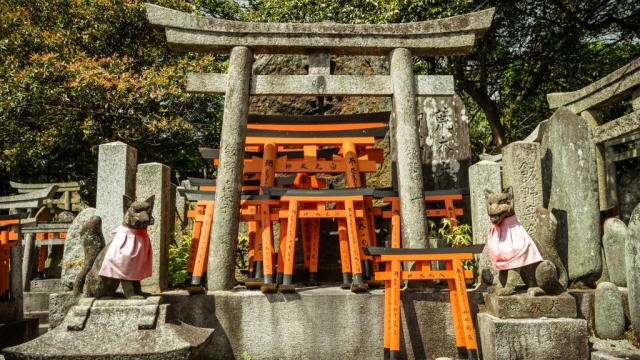
Whispers of the Ancients: Exploring Japan’s Enchanting Shinto Shrines

Japan, a land rich in history and tradition, is home to countless Shinto shrines that embody the spirit of its ancient beliefs. As one wanders through these sacred spaces, there is a palpable sense of connection to the past, where nature and spirituality intertwine in profound ways. Each shrine tells a unique story, reflecting the culture and customs that have shaped Japanese society over centuries.
Shinto shrines in Japan are more than just architectural marvels; they are sacred sites where rituals and ceremonies have been held to honor kami, the spirits revered in Shinto belief. From the iconic torii gates that mark the entrance to these hallowed grounds to the serene gardens that surround them, each element invites visitors to pause, reflect, and appreciate the tranquility that these spaces offer. Exploring these enchanting shrines reveals not only the artistry of Japanese design but also the deep-seated reverence for nature and the divine that continues to resonate in contemporary life.
History of Shinto Shrines
Shinto shrines in Japan have roots that trace back to the prehistoric period, with their origins intertwined with the indigenous beliefs and practices of the Japanese people. Early forms of worship were often tied to natural elements such as trees, mountains, and rivers which were considered sacred. These veneration practices gradually evolved, leading to the establishment of organized shrines dedicated to particular deities known as kami. This transformation marked the beginning of a more structured religious framework that would define Shintoism.
The formalization of Shinto shrines significantly progressed during the Yamato period, around the 4th to 7th century, when the belief system began to intertwine with political power. The construction of prominent shrines was often commissioned by rulers to assert their authority and divine legitimacy. One notable example is the Ise Jingu, dedicated to the sun goddess Amaterasu, which symbolizes the spiritual heart of Japan. During this time, shrines not only served a religious purpose but also became centers of community and governance.
With the arrival of Buddhism in Japan during the 6th century, the relationship between Shinto and Buddhism led to a unique syncretism. Many shrines incorporated Buddhist elements, and both belief systems coexisted, influencing each other in profound ways. Throughout the centuries, as Japan underwent periods of change, including the Kamakura and Edo periods, Shinto shrines evolved further, adapting to social and cultural shifts. The Meiji Restoration in the 19th century marked a significant turning point, as Shinto was established as a state religion, leading to the promotion and restoration of many shrines throughout the country.
Architectural Features
Shinto shrines in Japan exhibit distinctive architectural styles that reflect the values and beliefs of this ancient faith. One of the most notable elements is the use of natural materials, primarily wood, which symbolizes the connection between the spiritual and natural worlds. The structures are often built using simple yet elegant designs, embodying a sense of harmony with the surrounding environment. Roofs are typically thatched or made of cedar bark, curving upwards at the edges, which is not only visually striking but also serves to protect the sanctity of the space within.
Another characteristic feature of Shinto shrines is the torii gate, a traditional entryway that marks the boundary between the sacred and the profane. These gates vary in design, with some painted vermilion and others left in their natural wood state. The design of the torii gate serves as a symbol of transition, inviting visitors to leave behind their worldly concerns as they enter a realm devoted to the kami, or deities. The placement of these gates often follows the natural landscape, enhancing the serene beauty that surrounds the shrines.
神社めぐり
Finally, the inner sanctum of a Shinto shrine, known as the honden, is typically not accessible to the public. This sacred chamber houses the shrine’s kami and is designed to be simple yet imposing. The honden may be elevated on a platform, further emphasizing its significance. Surrounding space is often adorned with offerings and ritual objects, reflecting the ongoing relationship between worshippers and the deities they honor. The overall architectural design of Shinto shrines is a testament to their spiritual purpose, intended to foster tranquility and reverence for the natural world.
Cultural Significance
Shinto shrines in Japan hold a profound place in the cultural and spiritual fabric of the nation. They serve not only as places of worship but also as embodiment of the traditional beliefs and practices that have shaped Japanese identity for centuries. These sacred spaces are dedicated to kami, the spirits or gods in Shintoism, and act as a bridge between the physical and spiritual worlds. Their rituals, festivals, and ceremonies reflect the seasonal cycles and agricultural traditions, intertwining everyday life with the divine.
The architectural design of Shinto shrines is steeped in symbolism and meaning. From the torii gates that mark the entrance to the sacred space to the honden or main hall where kami are enshrined, each element serves to foster a connection with the spiritual realm. The aesthetic principles of simplicity and harmony with nature also highlight the cultural value placed on the environment in Shinto beliefs. Visitors often find themselves imbued with a sense of peace and tranquility as they traverse through these serene landscapes, further reinforcing the deep-rooted cultural appreciation for harmony and balance.
Shinto shrines also act as focal points for community gatherings and celebrations. Events such as New Year visits, weddings, and civic festivals are often held at these sites, underscoring their role as a communal space that strengthens social bonds. These gatherings not only highlight the continuity of Shinto practices but also encourage a sense of belonging among individuals and families. As such, shinto shrines in Japan are not merely places of worship; they are living symbols of cultural heritage, community connection, and the enduring spirit of the past.
Notable Shrines to Visit
One of the most iconic Shinto shrines in Japan is Fushimi Inari Taisha, located in Kyoto. This shrine is renowned for its thousands of vermillion torii gates, which create stunning pathways up the sacred Mount Inari. Visitors can walk along the winding trails, surrounded by lush greenery, while encountering various smaller shrines dedicated to Inari, the deity of rice and fertility. Fushimi Inari Taisha offers a unique experience that beautifully blends nature with spiritual reverence.
Another must-visit shrine is Meiji Jingu in Tokyo. Nestled in a peaceful forested area, this shrine honors Emperor Meiji and Empress Shoken. The approach to the shrine is marked by a grand torii gate, inviting visitors to explore the tranquil surroundings. The impressive main hall showcases traditional Shinto architecture, and the shrine grounds often host seasonal festivals that highlight Japan’s rich cultural traditions. Meiji Jingu serves as a serene escape from the bustling city life.
Lastly, Ise Jingu, located in Mie Prefecture, is considered one of the most sacred Shinto shrines. It consists of two main shrines, Naiku and Geku, each dedicated to different deities. The architecture of Ise Jingu is significant, as it follows the ancient tradition of rebuilding every 20 years to maintain purity and reflect the beliefs of renewal and continuity. Visitors to Ise Jingu can immerse themselves in a profound spiritual atmosphere while learning about the deep-rooted customs of Shintoism, making it an unforgettable destination.



